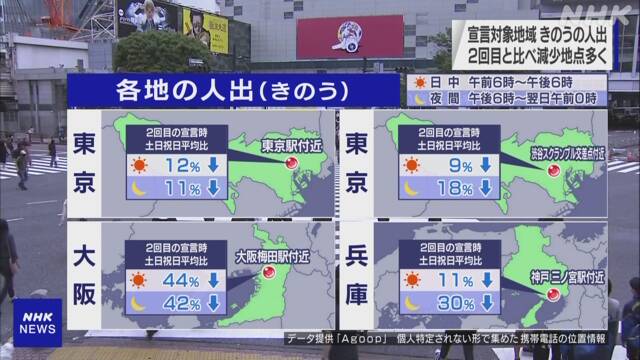The number of people on the 16th in areas where the state of emergency was declared was often lower than the average for Saturdays, Sundays, and holidays during the period when the second declaration was issued.
However, it is still more than the period of the first declaration.
NHK is a major location in the area where a state of emergency is declared, using mobile phone location data collected by IT-related company Agoop with the permission of the user in a non-personally identifiable manner. I analyzed the number of people.
The time analyzed is from 6 am to 6 pm during the day and from 6 pm to midnight the next day at night.
According to this, the number of people in Tokyo, Osaka, Hyogo, Kyoto, Aichi, and Fukuoka on the 16th of the declared areas decreased in many places compared to the average of Saturdays, Sundays, and holidays during the second declaration period. became.
▽ 12% decrease during the day and 11% decrease at night near Tokyo Station ▽
9% decrease during the day and 18% decrease at night near the Shibuya scramble intersection
▽ 44% decrease during the day and at night near Osaka Umeda Station 42% decrease
▽ 11% decrease in the daytime near Sannomiya station in Kobe city, 30% decrease in the nighttime
▽ 23% decrease in the daytime and 29% decrease in the nighttime near Kyoto station ▽
1% in the daytime near Nagoya station Decrease, 10% increase at night
▽ 19% decrease during the day near Hakata Station, unchanged at night.
In Hokkaido, which joined the target area of the declaration from the 16th, it decreased by 30% during the day and 40% at night compared to the average of the previous four weeks near Sapporo Station.
However, when comparing the 16-day population in these regions with the average of Saturdays, Sundays, and holidays during the first declaration period, all regions have more than doubled.

